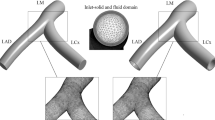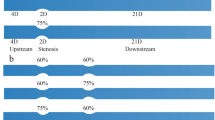Abstract
Atherosclerosis is one of the major cardiac diseases that affect a huge population all over the world leading to myocardial infarction (heart attack) and apoplexy (Eason G, Noble B, Sneddon IN, Series A, Mathematical and Physical Sciences. 247:529–551, 1955). Early disorder is due to deposits of fatty material or atheroma causing blocked blood flow and plaque formation. If there is a rupture of the plague in the carotid conduit, it typically leads to cessation of neural tissue (stroke) or myocardial infarction. Studying the hemodynamic of the blood vessels can determine the important factors for the local distribution and the development of vascular plaques. Experimental studies of the vascular replicas by idealized models have not been efficient where vessel geometry construction was an issue. Computational fluid dynamics (CFD)-fluent is used to build model to study the hemodynamic, wall shear stress distribution, and streamline patterns through stenosis; the pathophysiological and hemodynamic changes in the walls could provide more estimate on the degree of the disease.
Access this chapter
Tax calculation will be finalised at checkout
Purchases are for personal use only
Similar content being viewed by others
References
Bernad ES, Bernad SI, Sargan I, Craina ML. Saphenous vein graft patency after geometry remodeling. J Mech Med Biol. 2015;15(06):1540051.
Australian Institute of Health, Australian Institute of Health. Australia’s health. Australian Government Pub. Service; 2006.
Rybicki FJ, Melchionna S, Mitsouras D, Coskun AU, Whitmore AG, Steigner M, Nallamshetty L, Welt FG, Bernaschi M, Borkin M, Sircar J. Prediction of coronary artery plaque progression and potential rupture from 320-detector row prospectively ECG-gated single heart beat CT angiography: lattice Boltzmann evaluation of endothelial shear stress. Int J Cardiovasc Imaging. 2009;25(2):289–99.
Shanmugavelayudam SK, Rubenstein DA, Yin W. Effect of geometrical assumptions on numerical modeling of coronary blood flow under normal and disease conditions. J Biomech Eng. 2010;132(6):061004.
Johnston BM, Johnston PR, Corney S, Kilpatrick D. Non-Newtonian blood flow in human right coronary arteries: steady state simulations. J Biomech. 2004;37(5):709–20.
Soulis JV, Farmakis TM, Giannoglou GD, Louridas GE. Wall shear stress in normal left coronary artery tree. J Biomech. 2006;39(4):742–9.
Wootton DM, Ku DN. Fluid mechanics of vascular systems, diseases, and thrombosis. Annu Rev Biomed Eng. 1999;1(1):299–329.
Mehrabi M, Setayeshi S. Computational fluid dynamics analysis of pulsatile blood flow behavior in modelled stenosed vessels with different severities. Math Probl Eng. 2012;1:2012.
Harlow FH, Welch JE. Numerical calculation of time-dependent viscous incompressible flow of fluid with free surface. Phys Fluids. 1965;8(12):2182–9.
Tu C, Deville M. Pulsatile flow of non-Newtonian fluids through arterial stenoses. J Biomech. 1996;29(7):899–908.
Sankar DS, Lee U. Mathematical modeling of pulsatile flow of non-Newtonian fluid in stenosed arteries. Commun Nonlinear Sci Numer Simul. 2009;14(7):2971–81.
Chang CC, Atabek HB. The inlet length for oscillatory flow and its effects on the determination of the rate of flow in arteries. Phys Med Biol. 1961;6(2):303.
Chandran KB, Mun JH, Choi KK, Chen JS, Hamilton A, Nagaraj A, McPherson DD. A method for in-vivo analysis for regional arterial wall material property alterations with atherosclerosis: preliminary results. Med Eng Phys. 2003;25(4):289–98.
Author information
Authors and Affiliations
Editor information
Editors and Affiliations
Rights and permissions
Copyright information
© 2023 The Author(s), under exclusive license to Springer Nature Switzerland AG
About this chapter
Cite this chapter
Dhamodaran, H., Shreeram, B., Li, C. (2023). Hemodynamic Analysis of Bifurcated Artery Using Computational Fluid Dynamics. In: Ram Kumar, C., Karthik, S. (eds) Translating Healthcare Through Intelligent Computational Methods. EAI/Springer Innovations in Communication and Computing. Springer, Cham. https://doi.org/10.1007/978-3-031-27700-9_13
Download citation
DOI: https://doi.org/10.1007/978-3-031-27700-9_13
Published:
Publisher Name: Springer, Cham
Print ISBN: 978-3-031-27699-6
Online ISBN: 978-3-031-27700-9
eBook Packages: EngineeringEngineering (R0)




